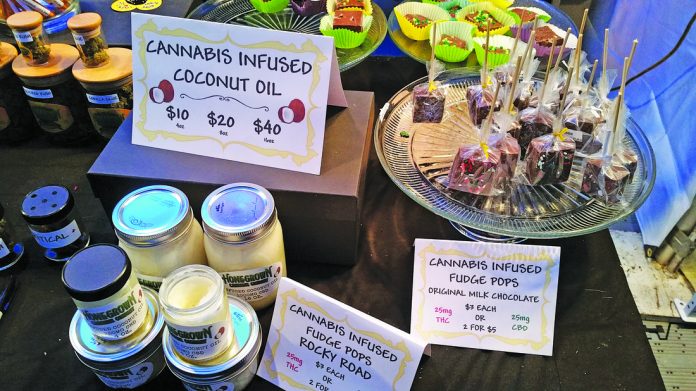
The tables were filled with cannabis-infused edibles, from granola chunks to dark chocolate bites. A nearby booth had flavored cannabis milk dished out in small plastic cups, the enthusiastic pitchman warning of the potency of the blackberry-scented drink. Then there were the topicals—thick lotions that smelled like lemongrass and lavender—and serums, tinctures and salves. But, this would not be the Emerald Cup, Northern California’s premier cannabis conference without plenty of the holy green. Exhibitors displayed the crystal-laden flower, its buds cured and trimmed until they were like nuggets. Growers displayed them in glass jars, propped on sticks so attendees could get a 360-degree view or in curio boxes normally used to store cherished mementos. Still others had bags of the stuff and without much fanfare hoisted them onto the table so attendees could catch a whiff of its pungent, heady smell at the Emerald Cup.
The last medical cannabis cup until California transitions to recreation next year, the fulfillment of Proposition 64, passed by voters in 2016, the atmosphere at the Emerald Cup was electric but bittersweet. A lone sign read, “RIP Prop 215,” a nod to the landmark medical cannabis legislation passed by voters in 1996. Over the years, cannabis growers, formed into nonprofit collectives, provided the medicinal plant to patients to treat any number of ills, from stress, anxiety and PTSD to seizures, glaucoma and chronic pain. Some of these pioneers lamented the loss of the old medical scene and looked into the future when investors and corporations only seeing dollar signs would take over the industry, buying out or overtaking the mom and pop collectives and growers who saw cannabis as a healing way of life.
It is estimated that sales of cannabis in California could reach $5 billion. Since Proposition 64 passed last year local jurisdictions across the state have had to make the important decision on whether to allow cannabis suppliers, retailers, processors, etc., to operate within their boundaries. Some, like Hollister have embraced the new industry, while enacting specific guidelines in relation to activity and location. Then, there are others like San Juan Bautista, which has chosen to temporarily ban all commercial activity to give the city time to draft an ordinance and set of rules that work for them.
A cannabis retailer in Oregon, which legalized adult use in 2014, said with regulation, he estimated up to 50 percent of cannabis brands and products had folded. Keeping up with state-mandated rules on packaging, dosing, labeling and accounting was too expensive and cumbersome for many of the people who got into the industry for kicks or for passion. Suddenly, cannabis was a real industry and not everyone could keep up with the changing landscape.
So far, the District of Columbia and eight states: Alaska, Maine, Colorado, Massachusetts, Nevada, Washington, Oregon and California have legalized the use of both recreational and medical cannabis. It is not difficult to see that with the full adoption of Proposition 64 in the state, California will be the biggest player in the country by far. Expect to see tour groups from Europe, Asia and every corner of the world flocking to California to experience legal cannabis as they visit the Hollywood sign or the Golden Gate Bridge. The green rush is happening folks and the state may never be the same.









